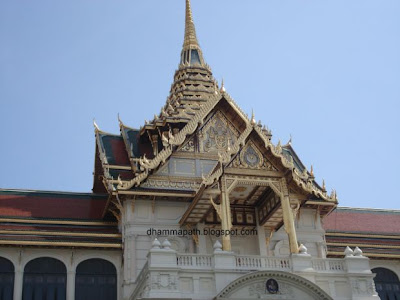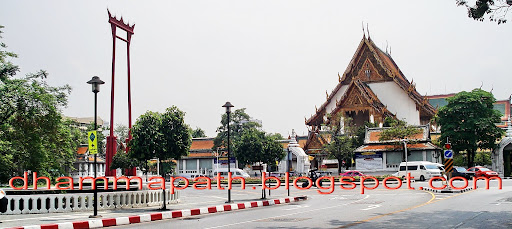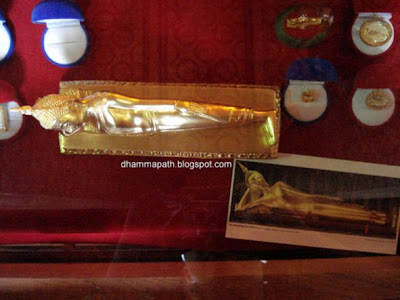The Wat Phra Kaew ~ Temple of the Emerald Buddha, full official name Wat Phra Sri Rattana Satsadaram, is regarded as the most sacred Royal Temple in Thailand. It is located in the historic centre of Bangkok within the precincts of the Grand Palace.
 The main entrace of Wat Phra Kaew complex as seen from the road.
The main entrace of Wat Phra Kaew complex as seen from the road. The Thai army are guarding at the entrance of Wat Phra Kaew.
The Thai army are guarding at the entrance of Wat Phra Kaew.  View of Wat Phra Kaew Complex from Northeast.
View of Wat Phra Kaew Complex from Northeast. 


The former residence of the King, the Grand Palace, adjoins the temple. The King makes use of this Grand Palace for ceremonial functions such as the Coronation Day. The King’s present residence is to the north of this Grand Palace and is known as the Chitlada Palace.
 The Chakri Mahaprasat is the largest hall in the Grand Palace, built in 1882 by British architects, the architecture of which is fusion of Italian renaissance and Traditional Thai architecture.
The Chakri Mahaprasat is the largest hall in the Grand Palace, built in 1882 by British architects, the architecture of which is fusion of Italian renaissance and Traditional Thai architecture. 
 The temple grounds also depict three Chedis to its immediate north, which represent the changing centres of Buddhist influence. One such shrine to the west of the temple is the Phra Si Ratana Chedi, a 19th-century stupa built in Sri Lankan style enshrining ashes of the Buddha.
The temple grounds also depict three Chedis to its immediate north, which represent the changing centres of Buddhist influence. One such shrine to the west of the temple is the Phra Si Ratana Chedi, a 19th-century stupa built in Sri Lankan style enshrining ashes of the Buddha.

Rama I also built a Phra Mondop library in Thai style, in the middle of the complex, known as the "Phra Mondop". The library houses an elegantly carved Ayutthaya-style mother-of-pearl doors, bookcases with the Tripitaka (sacred Buddhist manuscripts), human-and dragon-headed nagas (snakes), and images of Chakri Kings.
 During the 19th century, the Royal Pantheon was built in Khmer style to the east of the temple, which is kept open for only one day in year, in the month of October to commemorate the founding of the Chakri dynasty.
During the 19th century, the Royal Pantheon was built in Khmer style to the east of the temple, which is kept open for only one day in year, in the month of October to commemorate the founding of the Chakri dynasty. The entire complex, including the temples, is bounded by a compound wall which is one of the most prominent part of the wat is about 2 kilometres (6,600 ft) length. The compound walls are decorated with typically Thai murals, based on the Indian epic Ramayana. In Thai these murals are known to form the Ramakian, the Thai national epic, which was written during the reign of Rama I. The epic stories formed the basic information to draw the paintings during the reign of King Rama I (1782–1809). These paintings are refurbished regularly. The murals, in 178 scenes, starting with the north gate of the temple illustrates the complete epic story of Ramayana sequentially, in a clockwise direction covering the entire compound wall. The murals serve to emphasise human values of honesty, faith, and devotion.
The entire complex, including the temples, is bounded by a compound wall which is one of the most prominent part of the wat is about 2 kilometres (6,600 ft) length. The compound walls are decorated with typically Thai murals, based on the Indian epic Ramayana. In Thai these murals are known to form the Ramakian, the Thai national epic, which was written during the reign of Rama I. The epic stories formed the basic information to draw the paintings during the reign of King Rama I (1782–1809). These paintings are refurbished regularly. The murals, in 178 scenes, starting with the north gate of the temple illustrates the complete epic story of Ramayana sequentially, in a clockwise direction covering the entire compound wall. The murals serve to emphasise human values of honesty, faith, and devotion.

 Ramakien statues holding the Golden Chedi.
Ramakien statues holding the Golden Chedi.
The Chinese statues venerated in front the Yaksha statues.

The compound view near the Phra Mondop library.
 Giant demon (Yaksha) guarding an exit to Grand Palace.
Giant demon (Yaksha) guarding an exit to Grand Palace. The overview of the Ubosot.
The overview of the Ubosot. Garuda and Nagas, at the outside of the Ubosot Wat Phra Kaew.
Garuda and Nagas, at the outside of the Ubosot Wat Phra Kaew. Phra Phuttha Maha Mani Rattana Patimakon ~ Emerald Buddha. Photography inside the Ubosot of Emerald Buddha is strictly forbidden. This is not just a requirement of the temple, inside the Ubosot taking pictures of Buddha images is against the law. This photo taken was outside the Ubosot. The Emerald Buddha statue venerated in Wat Phra Kaew is glittering in gold.
Phra Phuttha Maha Mani Rattana Patimakon ~ Emerald Buddha. Photography inside the Ubosot of Emerald Buddha is strictly forbidden. This is not just a requirement of the temple, inside the Ubosot taking pictures of Buddha images is against the law. This photo taken was outside the Ubosot. The Emerald Buddha statue venerated in Wat Phra Kaew is glittering in gold..
See more amulets of Wat Phra Kaew at :
.
See more other Thai amulets at:
http://www.thaiamulets-dhammapath.blogspot.com/
http://www.thaiamulets-dhammapath.blogspot.com/





 The giant Reclining Buddha at Wat Pho. On the inner wall of this vihara, you will see mural paintings of three topics:
The giant Reclining Buddha at Wat Pho. On the inner wall of this vihara, you will see mural paintings of three topics: 






 Wat Pho has 4 big chedis which were built on separate occasions to commemorate the first three kings of the Chakri Dynasty (two chedis for King Rama III).
Wat Pho has 4 big chedis which were built on separate occasions to commemorate the first three kings of the Chakri Dynasty (two chedis for King Rama III).


















 The row of Buddha statues at the right side.
The row of Buddha statues at the right side.
